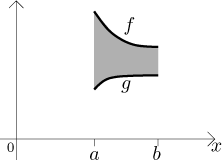
Consider the region R bounded from above by the graph of a function
f and from below by the graph of a function g on an interval

First assume that the function f is positive and g is identically zero - that is, we consider the region under the graph of f. We revolve this region about the x-axis:
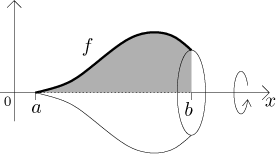
To find the volume, we split the x-axis into segments of size dx. For one such segment positioned at x, the vertical strip under the graph of f is so thin that we can think of its top as a straight line. If we rotate it, the resulting solid is actually a truncated cone.
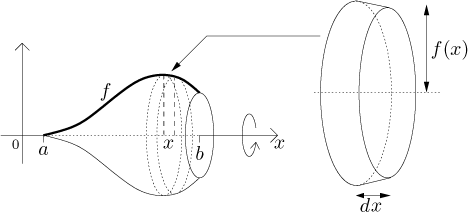
Since its height dx is so small, we can approximate its shape by a
cylinder of identical height and with radius equal to the average of the top
and bottom radius of the cone, namely f (x). The volume of such
a cylinder is easy to calculate, it is the area of the base times the height.
In fact, since these cylinders have infinitely small heights dx, it
may be better to think of them as discs with thickness dx and radii
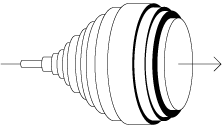
Summing up the volumes we get

Now we look at a region between two graphs of positive function rotated about the x-axis:
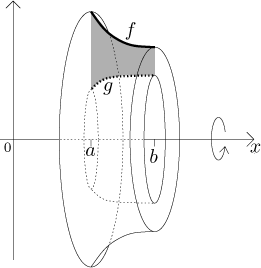
The volume of this solid is the volume of the whole solid determined by f minus the volume of the hole, which is the solid determined by g:
![]()
We can also see it as a sum of many discs with holes determined by splitting
the x-axis into segments of size dx. Each disc has thickness
dx, the outer radius is
Now if we rotate about a different horizontal axis given by
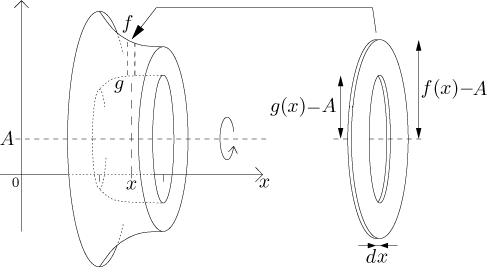
Thus we get the following:
Fact (Disc method).
Consider the region R bounded from above by the graph of a function f and from below by the graph of a function g on an interval[a,b]. Let A be a number such thatA < min(g). If f and g are continuous, the volume of the solid obtained by rotating the region R about an axis of rotation given byy = A is equal to
Consider the region R bounded from above by the graph of a function
f and from below by the graph of a function g on an interval
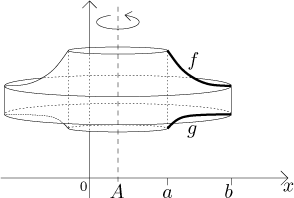
Since we now have some experience, we will try to deduce the volume formula
directly for this general case. Again, we start by splitting the interval
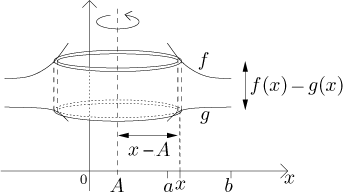
Since it is so thin, we can approximate its volume by multiplying its
surface by its thickness dx. What is the surface? By unwrapping the
shell we obtain a rectangle. Its height is equal to the height of the
rotated strip, that is,
So we can calculate the volume of one shell. The body can be decomposed into many very thin shells.
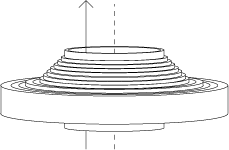
Adding all their volumes we get

In other words, we have the following:
Fact (Shell method).
Consider the region R bounded from above by the graph of a function f and from below by the graph of a function g on an interval[a,b]. Let A be a number such thatA < a. If f and g are continuous, the volume of the solid obtained by rotating the region R about an axis of rotation given byx = A is equal to
Consider a parametric curve
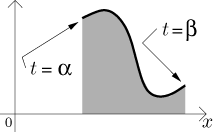
Now we will rotate this region in turn about a horizontal and vertical axis
and find the resulting volume. The calculations will actually be just as
above, since we again use the idea of the disc method and the shell method -
take a slice and revolve it. The only difference is that now we have
parametric expressions for the coordinates, which will appear as radii of
discr, respective heights and radii of rotation of shells. Also the thickness
of a disc/shell will be different, we use the transformation formula for
differential:
Fact.
Consider a parametric curvex = x(t), y = y(t) for t from[α,β]. Assume thaty(t) ≥ 0 for all t andx(t) is monotone. Assume also that y and x′ are continuous. Let R be the region under this curve.The volume of the solid obtained by revolving the region R about a horizontal axis of rotation given by
y = A, whereA ≤ 0, is
The volume of the solid obtained by revolving the region R about a vertical axis of rotation given by
x = A, whereA < min(x(t)), is
Surface of a solid of revolution
Back to Theory - Applications